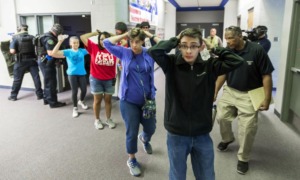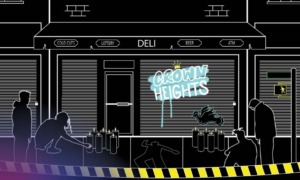 DIMJI/SHUTTERSTOCK
DIMJI/SHUTTERSTOCK
The U.S. Department of Justice recently released two statistical reports that appear to stand in contrast. A report released in June of this year states that in 2018, law enforcement agencies made the fewest number of arrests of juveniles in almost 40 years. But a different report, released in April, shows that juvenile homicide cases spiked by 35% between 2014 and 2018, which overlaps with the period of the June report.
The ostensible discrepancy between these two reports, if viewed without sufficient context, can potentially lead to some misinterpretations and misunderstandings. In particular, given what is occurring currently with regards to the Black Lives Matter movement and heightened tensions surrounding police-community relations, caution should be used when these statistics are directly cited in relation to cases involving Black residents in urban communities.
Criminologist Richard Rosenfeld has previously pointed out the problematic nature of centering the statistical rise in homicides around a narrative about tensions between the police and Black communities. This idea, pushed by some commentators in the popular media, that the increase in homicides was attributed to law enforcement agencies reducing their policing in Black neighborhoods as a result of police-community tensions, is often referred to as the Ferguson Effect. To date, however, research has not found evidence of an actual connection between the Ferguson Effect and increased rates of homicide.
Increase in juvenile homicide is part of larger trend
What needs to be clarified about the spike of homicides between 2014 and 2018 is that the increase was across the board with respect to race/ethnicity, age, sex and geographic location. This means that while it is technically true that there were more homicides involving Blacks during these years, the same was also true for everyone else.
Next, since the juvenile justice system varies in numerous ways from the adult system, it makes sense to point out juvenile-specific statistics such as the 2014-18 increase in juvenile homicides. However, just as the increase was not limited to Black communities, it was not limited to juveniles either.

Jennifer Peck
It is certainly possible that the precise mix of factors contributing to an increase in overall homicides vary depending on the specific demographic group and geographic location. For example, among whites in rural areas, there is evidence that drug-related killings resulting from the opioid epidemic were a major contributing factor.
Meanwhile, for Black residents in urban areas, research does show that minorities have more negative perceptions of the police compared to whites, though as already stated, evidence does not support the Ferguson Effect hypothesis for the rise in violence. Ruptures in race relations between urban communities and police are but one factor in a matrix of contributing issues. Unequal access to health care and social support services, a higher presence of gangs and more frequent exposure to various community trauma results in a melting pot of negative situations and a potential desensitization to (and normalization of) violence.
One factor that is almost certain to have played a major role in the increase in homicide is the greater availability of firearms, as the spike of homicides between 2014 and 2016 almost exclusively involved the use of guns. We may be witnessing a similar phenomenon now, to a degree, with the recent surge of gun violence across U.S. cities in 2020, which a new University of California at Davis study argues is also a direct result of an increase in gun purchases and ownership.
Practical ways to curb gun violence, juvenile homicide
Now that we have examined the necessary context for viewing the spike in juvenile homicide as a part of the rise in homicides in general, we can discuss various practical approaches to potentially mitigate this lethal problem.
First and foremost, as with any complex problem whose roots run deep, an effective approach must be holistic, comprehensive and preventative (preventing tragedy is always preferable to doing something about it afterwards). It must utilize cooperation among law enforcement and community partners, social service agencies, educational institutions and economic resources.
Next, evidence-based policing should always be prioritized. Policing policies that are effective in certain areas do not necessarily have the intended outcome in others. With empirical research, statistical analysis and collaborations between researchers and law enforcement agencies, we can better determine which approaches meet the needs of different areas and demographics.
Building trust between police and communities is another large hurdle, but it is crucial. It is no surprise that communities are more likely to collaborate with the police if they trust them. Community policing initiatives, when used appropriately, can improve citizens’ perceptions of the police (and vice versa), empower both to work together and share the responsibility to help keep their communities safe.
Law enforcement agencies also need to use their data to continually analyze the external conditions of the neighborhood they are policing. By the time reports like the ones released this year from the Department of Justice are published, years have already gone by. Police need to interpret their data to see where, and possibly why, homicides are occurring in their communities right now. Analyzing data can help illuminate why, for example, juvenile homicides have risen despite the drop in juvenile arrests overall.
Efforts like this could be strengthened by increased collaborations between the police and academic researchers. While potentially challenging, such collaborations, when they are successful, can spark innovations to how law enforcement agencies think and act, as well as be transformative for both sides in positive ways.
Finally, there need to be targeted intervention programs specifically designed to reduce juvenile homicides and youth violence in general. Boston’s Group Violence Intervention program (GVI) and the ensuing “Boston miracle” is an example of such a targeted intervention program. Developed in the 90s by David M. Kennedy, a professor of criminal justice, GVI is now widely viewed by other cities and even other countries, as a model par excellence for preventing and reducing youth violence.
In fact, the GVI is an impressive example of all the principles outlined above. It is a holistic model that has law enforcement, social services and local communities working together. It is evidence-based. It fosters trust between law enforcement and the communities they serve by having them work closely together. It is a targeted intervention program created specifically to ameliorate youth violence. Also important, it was originally designed by a professor of criminal justice, supporting the idea that police and academics can collaborate in effective and constructive ways.
The loss of life though violence is clearly always a matter of grave concern and when it involves our youth it takes on an added dimension of tragedy. However, it is important to understand that the surge in juvenile homicide is not unique to juveniles but is part of an increase in homicides overall. Moreover, it is not limited to Black communities but cuts across demographic and geographic lines.
The practical approaches outlined above are therefore intentionally broad and universal. When tailored to the unique qualities of specific communities, they can effectively help reduce juvenile violence and homicides, regardless of where they are occurring or whom they involve.
Jennifer Peck, Ph.D. is an associate professor in the Department of Criminal Justice at the University of Central Florida. Her research interests focus on racial/ethnic disparities in the juvenile justice system, treatment of disadvantaged groups throughout juvenile court processing and special populations in courts and corrections.
This column has been updated.































